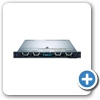DataCore has a fine reputation in the software defined storage (SDS) market as its SANsymphony delivers an excellent range of storage virtualisation features with a keen focus on data availability, scalability and performance
Not content to rest on its laurels, DataCore now makes a bold move into hardware solutions with its HCI-Flex hyperconverged infrastructure appliances.
Offered in small, medium and large configurations, the HCI-Flex appliances are turnkey solutions combining virtualisation, storage and compute services in a single platform. HCI-Flex aims to reduce support costs and complexity as DataCore offers a single point of contact for all hardware and software components.
The hardware comes courtesy of Dell EMC's classy PowerEdge R640XL and R740XL rack servers available with a choice of Xeon Scalable CPUs, DDR4 memory capacities and hybrid SSD/HDD or all-SSD storage configurations. Virtualisation hosts can be Hyper-V or VMware ESXi hypervisors while DataCore's SANsymphony provides a solid storage foundation.
Our review system may be the entry-level VMware model but it offers a powerful package with two Xeon Scalable Silver 4110 CPUs and 128GB of DDR4 memory in the driving seat. ESXi is preinstalled on dual mirrored M.2 SSDs managed by the server's BOSS card while two hot-swap 480GB SAS3 SSDs and three 2.4TB SAS3 HDDs present SANsymphony tiered disk pools for direct use as datastores to VMs.
Prior to deploying the appliance, its eight 10-Gigabit ports should be connected using highly available switch configurations, static IP addresses set aside for ESXi, vCenter Server plus SANsymphony and resolvable FQDNs manually created for each host. DataCore's wizard handles all installation and initial configuration and you'll meet this when the appliance is first powered up.
Care should be taken when providing the static IP address for the ESXi host as changing this later on may require additional steps. Once ESXi is loaded, the wizard creates a Windows Server 2016 VM hosting SANsymphony which you log in to, run the HCI-Flex installation manager and enter all the hostname and IP address details previously created.
The wizard then spends the next 30 minutes to an hour (depending on environment) configuring the hosts and setting SANsymphony up with a tiered storage pool that presents a high-capacity virtual disk (VD) as a production ESXi datastore. Thin provisioning is enabled on all pools and the SANsymphony profile assigned to the default VD ensures blocks are migrated between the SSD and HDD tiers based solely on how hot the data is.
To create production VMs, you simply load the vSphere web client, select the HCI-Flex appliance as the compute resource and store your VMs on the SANsymphony datastore along with their snapshots. If you want more datastores, you can access the SANsymphony host via the VMware remote console or RDP, create as many VDs as required and serve them up to the ESXi host.
As the product name hints, flexibility is a high priority as more physical storage can be added to the appliance as required and SANsymphony can serve up storage directly to external hosts. HCI-Flex retains your investment in existing storage arrays as these can be integrated into SANsymphony and their capacity added to existing disk pools or used to create new ones. Another key feature of HCI-Flex is that high availability can be achieved with only two appliances and SANsymphony performs synchronous mirroring and real time I/O replication across them both.
Product: HCI-Flex
Supplier: DataCore Software
Web site: www.datacore.com
Tel: +44 (0) 118 908 0840
Price: From £15,302 exc. VAT
| Verdict: HCI-Flex delivers a versatile and scalable HCI solution whilst management gets a big boost as it integrates tightly with DataCore's Insight Services (DIS) cloud platform. This presents a single pane of glass for monitoring your entire storage infrastructure and uses AI and ML to provide storage health insights and predictive analysis. |


